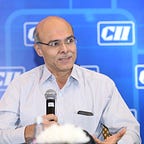5G Millimeter Wave — Good for the health of the Indian Operators
What motivated me to make such a statement? It is not influenced by my biases, but by the manner, in which the TRAI’s recommendation is set up. Let me explain.
Operator’s Outflow (Auction)
India has four virgin bands for 5G — a)600 MHz; b)700 MHz; d)3500 MHz; c)26/28 GHz.
600/700 MHz
Now, the price of 600/700 MHz is approximately 8% more than that of the existing 800 MHz in Rs Cr/MHz. But the problem is that unlike 4G when the operators need spectrum in smaller chunks, in the case of 5G they will need 4 times the quantum of the spectrum than that of 4G. This will increase the outflow by 4 times. In order to get a perspective let's do the numbers. For example, 2x20 MHz of 700 MHz will cost the operators Rs 78,540 Cr ($10.33 Billion US) at the rate of Rs 3927 Cr/MHz.
3500 MHz
The price of 3500 MHz is now 35.5% less than the earlier announced price of TRAI in 2018. Now since TRAI didn’t get an opportunity to get this band tested in an auction, they had no option but to follow the same strategy for pricing this band as they did last time- i.e 30% of the price of the 1800 MHz band. Hence for an operator to get 100 MHz of TDD spectrum in this band (2x50 MHz FDD equivalent), they need to shell out Rs 31,700 Cr ($4.17 Billion USD).
26/28 GHz
This is a totally new band, where TRAI never got the opportunity in the past to price. Hence, this time they had full flexibility to bring the price down to an optimal level. The total spectrum available in this band is 4250 MHz (Huge!). Hence, the operators can easily gun for 1000 MHz each (assuming 4 operators). The price of 26/28 GHz is set as 2.2% of that of 3500 MHz based on international data. Hence, it will cost the operators only Rs 6974 Cr ($ 918 Million USD) to take 1000 MHz of spectrum in this band (10 times more spectrum than that of 3500 MHz). In other words, 10 times more spectrum than 3500 MHz at just 2.2% of its cost! (one a per MHz basis)
Operator’s Outflow (SUC)
There is one more factor that will drive the operator's decision — which is how much cash outflow they will be able to save by acquiring spectrum in a particular band. Now you know that recently GOI had announced that all the spectrum that the operator will acquire in any band will attach 0% SUC (spectrum usage charge). SUC rate is laid out in %, and the cost to the operator is a value that is calculated using this rate on the total revenues that they end up generating. For example, assume an operator generates yearly revenue of Rs 100, then @ 3% SUC rate, Rs 3 will go to the government as spectrum usage charge. But since all bands had different SUC rates, the DOT (department of telecom) has devised a formula in order to calculate the combined SUC rate (called weighted average rate) applicable to the operator for holding spectrum in different bands acquired at different points of time (through auctions) in the past years. In order to get a better understanding please read my earlier note — “Indian New SUC Rule — An Incentive to acquire more 5G spectrum”
Operator’s Savings on SUC
Now the question one might ask that how much the operators can save by acquiring spectrum in the millimeter-wave bands (26/28 GHz), and how will the value compare to the 3500 MHz? Here is the calculation-
3500 MHz
Let's say an operator has 2x50 MHz of existing spectrum for which they are paying a SUC of 3.5% (total for access and MW spectrum). Now let us assume that they acquire 100 MHz of 3500 MHz band for Rs 31,700 Cr. The saving in SUC can be calculated as under-
SUC (WA % Rate) = (50 x 0.035+ 50 x 0)/100 = 1.75%. [Note — 100 MHz of TDD is equal to 2x50 MHz of FDD]. Hence, the SUC will drop from 3.5 % to 1.75%; i.e Net SUC saving is 1.75%. Now if we assume the operator’s annual revenues as Rs 80,000 Cr, then the yearly savings for the operators will be Rs 1400 Cr. I.e to save Rs 1400 Cr/Year the operator has to shell out Rs 31,700 Cr in the auctions.
26/28 GHz
Now let’s assume that the operator acquired 1000 MHz of 5G spectrum in the 26/28 GHz band at the price of Rs 6974 Cr. The other things remain constant, let's put the value in the formula to see the impact.
SUC (WA % Rate) = (50 x 0.035 + 500 x 0)/550 = 0.318%
Hence, the operator will be able to save 3.182% on SUC. Which translates to Rs 2545 Cr/Year. In other words, by spending just 4.5 times less in the 5G auction (compared to 3500) to get a 26/28 GHz spectrum, the operators will end up saving Rs 2545 Cr (1.8 times of the 3500 case) on annual cash flow. This is a huge upside on the operator’s valuation!
Conclusion
In my view, the TRAI did not deliberately engineer this outcome. This emanated naturally due to the legacy issue and constraints that TRAI faced in pricing the 3500 MHz band, as explained above in this note. This also proves that the prices of 600/700 and 3500 MHz band is way high compared to their natural realistic numbers as they should have been. Hopefully, these distortions (high price of 600/700/3500 MHz) will get corrected as well in the future.
(Views expressed are of my own and do not reflect that of my employer)
PS: Find the list of other relevant articles in the embedded link.
